| Solar eclipse of May 9, 1967 | |
|---|---|
| Type of eclipse | |
| Nature | Partial |
| Gamma | 1.1422 |
| Magnitude | 0.7201 |
| Maximum eclipse | |
| Coordinates | 62°30′N 168°06′W / 62.5°N 168.1°W |
| Times (UTC) | |
| Greatest eclipse | 14:42:48 |
| References | |
| Saros | 147 (20 of 80) |
| Catalog # (SE5000) | 9436 |
A partial solar eclipse occurred at the Moon's ascending node of orbit on Tuesday, May 9, 1967,[1] with a magnitude of 0.7201. A solar eclipse occurs when the Moon passes between Earth and the Sun, thereby totally or partly obscuring the image of the Sun for a viewer on Earth. A partial solar eclipse occurs in the polar regions of the Earth when the center of the Moon's shadow misses the Earth.
A partial eclipse was visible for parts of North America and Northern Europe.
Eclipse details
[edit]Shown below are two tables displaying details about this particular solar eclipse. The first table outlines times at which the moon's penumbra or umbra attains the specific parameter, and the second table describes various other parameters pertaining to this eclipse.[2]
| Event | Time (UTC) |
|---|---|
| First Penumbral External Contact | 1967 May 09 at 12:37:20.4 UTC |
| Greatest Eclipse | 1967 May 09 at 14:42:47.7 UTC |
| Ecliptic Conjunction | 1967 May 09 at 14:55:56.3 UTC |
| Equatorial Conjunction | 1967 May 09 at 15:36:05.9 UTC |
| Last Penumbral External Contact | 1967 May 09 at 16:47:49.8 UTC |
| Parameter | Value |
|---|---|
| Eclipse Magnitude | 0.72009 |
| Eclipse Obscuration | 0.63352 |
| Gamma | 1.14218 |
| Sun Right Ascension | 03h03m17.2s |
| Sun Declination | +17°16'38.0" |
| Sun Semi-Diameter | 15'50.5" |
| Sun Equatorial Horizontal Parallax | 08.7" |
| Moon Right Ascension | 03h01m40.6s |
| Moon Declination | +18°14'18.0" |
| Moon Semi-Diameter | 14'51.1" |
| Moon Equatorial Horizontal Parallax | 0°54'30.4" |
| ΔT | 37.7 s |
Eclipse season
[edit]This eclipse is part of an eclipse season, a period, roughly every six months, when eclipses occur. Only two (or occasionally three) eclipse seasons occur each year, and each season lasts about 35 days and repeats just short of six months (173 days) later; thus two full eclipse seasons always occur each year. Either two or three eclipses happen each eclipse season. In the sequence below, each eclipse is separated by a fortnight.
| April 24 Descending node (full moon) |
May 9 Ascending node (new moon) |
|---|---|
 |

|
| Total lunar eclipse Lunar Saros 121 |
Partial solar eclipse Solar Saros 147 |
Related eclipses
[edit]Eclipses in 1967
[edit]- A total lunar eclipse on April 24.
- A partial solar eclipse on May 9.
- A total lunar eclipse on October 18.
- A total solar eclipse on November 2.
Metonic
[edit]- Preceded by: Solar eclipse of July 20, 1963
- Followed by: Solar eclipse of February 25, 1971
Tzolkinex
[edit]- Preceded by: Solar eclipse of March 27, 1960
- Followed by: Solar eclipse of June 20, 1974
Half-Saros
[edit]- Preceded by: Lunar eclipse of May 3, 1958
- Followed by: Lunar eclipse of May 13, 1976
Tritos
[edit]- Preceded by: Solar eclipse of June 8, 1956
- Followed by: Solar eclipse of April 7, 1978
Solar Saros 147
[edit]- Preceded by: Solar eclipse of April 28, 1949
- Followed by: Solar eclipse of May 19, 1985
Inex
[edit]- Preceded by: Solar eclipse of May 29, 1938
- Followed by: Solar eclipse of April 17, 1996
Triad
[edit]- Preceded by: Solar eclipse of July 7, 1880
- Followed by: Solar eclipse of March 9, 2054
Solar eclipses of 1964–1967
[edit]This eclipse is a member of a semester series. An eclipse in a semester series of solar eclipses repeats approximately every 177 days and 4 hours (a semester) at alternating nodes of the Moon's orbit.[3]
The partial solar eclipses on January 14, 1964 and July 9, 1964 occur in the previous lunar year eclipse set.
| Solar eclipse series sets from 1964 to 1967 | ||||||
|---|---|---|---|---|---|---|
| Ascending node | Descending node | |||||
| Saros | Map | Gamma | Saros | Map | Gamma | |
| 117 | June 10, 1964 Partial |
−1.1393 | 122 | December 4, 1964 Partial |
1.1193 | |
| 127 | May 30, 1965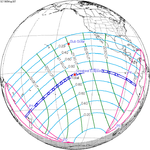 Total |
−0.4225 | 132 | November 23, 1965 Annular |
0.3906 | |
| 137 | May 20, 1966 Annular |
0.3467 | 142 | November 12, 1966 Total |
−0.33 | |
| 147 | May 9, 1967 Partial |
1.1422 | 152 | November 2, 1967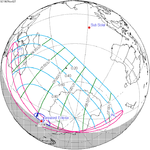 Total (non-central) |
1.0007 | |
Saros 147
[edit]This eclipse is a part of Saros series 147, repeating every 18 years, 11 days, and containing 80 events. The series started with a partial solar eclipse on October 12, 1624. It contains annular eclipses from May 31, 2003 through July 31, 2706. There are no hybrid or total eclipses in this set. The series ends at member 80 as a partial eclipse on February 24, 3049. Its eclipses are tabulated in three columns; every third eclipse in the same column is one exeligmos apart, so they all cast shadows over approximately the same parts of the Earth.
The longest duration of annularity will be produced by member 38 at 9 minutes, 41 seconds on November 21, 2291. All eclipses in this series occur at the Moon’s ascending node of orbit.[4]
| Series members 11–32 occur between 1801 and 2200: | ||
|---|---|---|
| 11 | 12 | 13 |
 January 30, 1805 |
 February 11, 1823 |
 February 21, 1841 |
| 14 | 15 | 16 |
 March 4, 1859 |
 March 15, 1877 |
 March 26, 1895 |
| 17 | 18 | 19 |
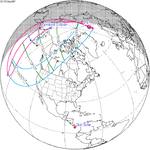 April 6, 1913 |
 April 18, 1931 |
 April 28, 1949 |
| 20 | 21 | 22 |
 May 9, 1967 |
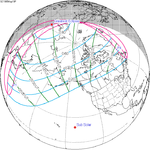 May 19, 1985 |
 May 31, 2003 |
| 23 | 24 | 25 |
 June 10, 2021 |
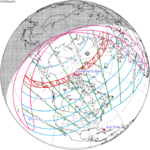 June 21, 2039 |
 July 1, 2057 |
| 26 | 27 | 28 |
 July 13, 2075 |
 July 23, 2093 |
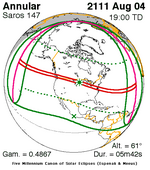 August 4, 2111 |
| 29 | 30 | 31 |
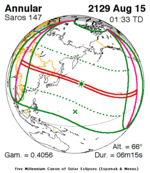 August 15, 2129 |
 August 26, 2147 |
 September 5, 2165 |
| 32 | ||
 September 16, 2183 | ||
Metonic series
[edit]The metonic series repeats eclipses every 19 years (6939.69 days), lasting about 5 cycles. Eclipses occur in nearly the same calendar date. In addition, the octon subseries repeats 1/5 of that or every 3.8 years (1387.94 days). All eclipses in this table occur at the Moon's ascending node.
| 22 eclipse events between December 13, 1898 and July 20, 1982 | ||||
|---|---|---|---|---|
| December 13–14 | October 1–2 | July 20–21 | May 9 | February 24–25 |
| 111 | 113 | 115 | 117 | 119 |
 December 13, 1898 |
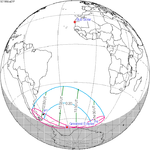 July 21, 1906 |
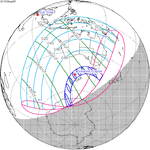 May 9, 1910 |
 February 25, 1914 | |
| 121 | 123 | 125 | 127 | 129 |
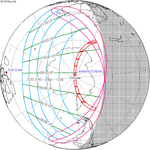 December 14, 1917 |
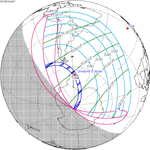 October 1, 1921 |
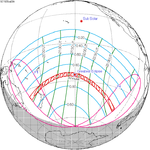 July 20, 1925 |
 May 9, 1929 |
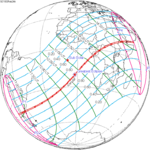 February 24, 1933 |
| 131 | 133 | 135 | 137 | 139 |
 December 13, 1936 |
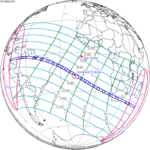 October 1, 1940 |
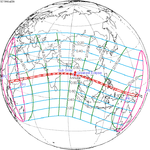 July 20, 1944 |
 May 9, 1948 |
 February 25, 1952 |
| 141 | 143 | 145 | 147 | 149 |
 December 14, 1955 |
 October 2, 1959 |
 July 20, 1963 |
 May 9, 1967 |
 February 25, 1971 |
| 151 | 153 | 155 | ||
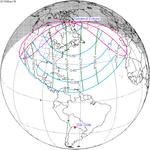 December 13, 1974 |
 October 2, 1978 |
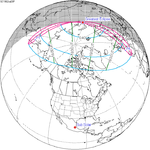 July 20, 1982 | ||
Tritos series
[edit]This eclipse is a part of a tritos cycle, repeating at alternating nodes every 135 synodic months (≈ 3986.63 days, or 11 years minus 1 month). Their appearance and longitude are irregular due to a lack of synchronization with the anomalistic month (period of perigee), but groupings of 3 tritos cycles (≈ 33 years minus 3 months) come close (≈ 434.044 anomalistic months), so eclipses are similar in these groupings.
| Series members between 1801 and 2087 | ||||
|---|---|---|---|---|
 August 17, 1803 (Saros 132) |
 July 17, 1814 (Saros 133) |
 June 16, 1825 (Saros 134) |
 May 15, 1836 (Saros 135) |
 April 15, 1847 (Saros 136) |
 March 15, 1858 (Saros 137) |
 February 11, 1869 (Saros 138) |
 January 11, 1880 (Saros 139) |
 December 12, 1890 (Saros 140) |
 November 11, 1901 (Saros 141) |
 October 10, 1912 (Saros 142) |
 September 10, 1923 (Saros 143) |
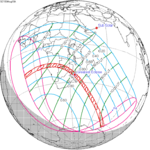 August 10, 1934 (Saros 144) |
 July 9, 1945 (Saros 145) |
 June 8, 1956 (Saros 146) |
 May 9, 1967 (Saros 147) |
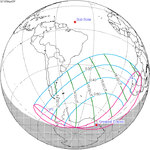 April 7, 1978 (Saros 148) |
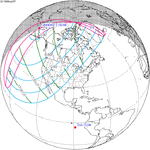 March 7, 1989 (Saros 149) |
 February 5, 2000 (Saros 150) |
 January 4, 2011 (Saros 151) |
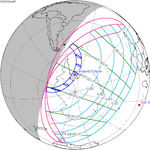 December 4, 2021 (Saros 152) |
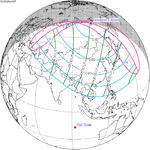 November 3, 2032 (Saros 153) |
 October 3, 2043 (Saros 154) |
 September 2, 2054 (Saros 155) |
 August 2, 2065 (Saros 156) |
 July 1, 2076 (Saros 157) |
 June 1, 2087 (Saros 158) | |||
Inex series
[edit]This eclipse is a part of the long period inex cycle, repeating at alternating nodes, every 358 synodic months (≈ 10,571.95 days, or 29 years minus 20 days). Their appearance and longitude are irregular due to a lack of synchronization with the anomalistic month (period of perigee). However, groupings of 3 inex cycles (≈ 87 years minus 2 months) comes close (≈ 1,151.02 anomalistic months), so eclipses are similar in these groupings.
| Series members between 1801 and 2200 | ||
|---|---|---|
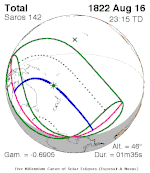 August 16, 1822 (Saros 142) |
 July 28, 1851 (Saros 143) |
 July 7, 1880 (Saros 144) |
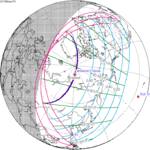 June 17, 1909 (Saros 145) |
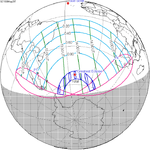 May 29, 1938 (Saros 146) |
 May 9, 1967 (Saros 147) |
 April 17, 1996 (Saros 148) |
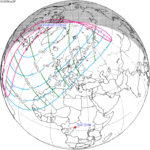 March 29, 2025 (Saros 149) |
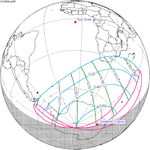 March 9, 2054 (Saros 150) |
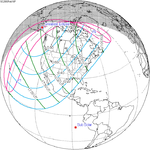 February 16, 2083 (Saros 151) |
 January 29, 2112 (Saros 152) |
 January 8, 2141 (Saros 153) |
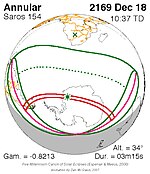 December 18, 2169 (Saros 154) |
 November 28, 2198 (Saros 155) |
|
References
[edit]- ^ "May 9, 1967 Partial Solar Eclipse". timeanddate. Retrieved 7 August 2024.
- ^ "Partial Solar Eclipse of 1967 May 09". EclipseWise.com. Retrieved 7 August 2024.
- ^ van Gent, R.H. "Solar- and Lunar-Eclipse Predictions from Antiquity to the Present". A Catalogue of Eclipse Cycles. Utrecht University. Retrieved 6 October 2018.
- ^ "NASA - Catalog of Solar Eclipses of Saros 147". eclipse.gsfc.nasa.gov.
External links
[edit]- Earth visibility chart and eclipse statistics Eclipse Predictions by Fred Espenak, NASA/GSFC



